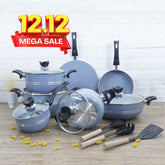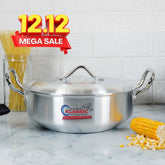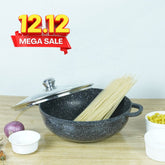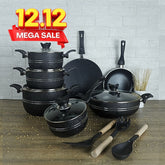Pressure Cooker Sizes: How to Choose the Right One for Your Family in Pakistan
Walk into any Pakistani kitchen, and you’re bound to find one staple appliance on the stove — the pressure cooker. Whether it’s cooking daal, softening mutton for a curry, or prepping a hearty yakhni, the right pressure cooker can save you both time and gas.
But choosing the right size? That’s where many people get stuck.
If you’ve ever asked yourself, “Will 5 litres be enough for our family?” or “Do I need something bigger for daawat days?”, you’re in the right place. This guide will walk you through the best pressure cooker sizes based on real needs of Pakistani households — from small families to joint setups.
Why Size Matters (Especially in Pakistani Kitchens)
Unlike Western kitchens where meals are often single-dish affairs, Pakistani cooking involves layered meals — rice, curry, daal, and sometimes multiple dishes in one go.
Using the wrong size cooker can lead to:
-
Overflowing food
-
Longer cooking times
-
Wasted gas or electricity
-
Over- or undercooked dishes
That's why it's crucial to pick a size that suits your daily lifestyle and special occasions.
🛍️ Best-Selling Sizes at Klassic Kitchenware (2025)
| Model Name | Size | Ideal For | Sale Price |
|---|---|---|---|
| Classic Series | 5L | Small families, daily meals | Rs. 6,999 |
| Ultima Series | 7L | Mid-sized households, qorma, biryani | Rs. 6,499 |
| Steamer Classic | 9L | Bulk meals + steaming option | Rs. 7,999 |
| Classic Series Jumbo | 11L | Daawats, family events | Rs. 8,999 |
👉 Explore all Pressure Cooker Sizes at Klassic Kitchenware
Pressure Cooker Size Guide for Pakistani Families
Here’s a simple breakdown to help you choose:
👨👩👧 3 to 5 Litres — Best for Small Families or Couples
-
Ideal for: Cooking rice, lentils, or curries for 2 to 4 people
-
Use Case: Daily meals like daal, aloo gosht, or matar pulao
-
Not ideal for: Hosting or bulk cooking
This is perfect if you're cooking one dish at a time or live in a small apartment.
👨👩👧👦 6 to 9 Litres — The Pakistani Standard
-
Ideal for: Families of 5 to 7 members
-
Use Case: Biryani, korma, haleem, and even steamed rice together with curry
-
Bonus: Models with built-in steamers let you multitask in one pot
This is the most common size found in urban Pakistani homes. It’s versatile and efficient.
🧕👳♂️👵👶 10 Litres & Above — Made for Joint Families & Daawats
-
Ideal for: 8+ people or large batches
-
Use Case: Eid feasts, daawat days, or storing meals for the week
-
Note: These take more time to heat but are extremely practical when needed
This size is often seen in homes where cooking for many is a daily routine. Still Confused Which Pressure Cooker Is Best to Buy.
🔗 Related Reading: Best Pressure Cookers in Pakistan (2025 Review & Buying Guide)
Size vs. Cooking Style — What Suits You?
| Meal Type | Recommended Size |
|---|---|
| Regular curry/daal | 5L–7L |
| Layered biryani | 7L–9L (or wider base) |
| Haleem/Nihari | 9L–11L |
| Steaming + curry combo | Look for steamer-compatible models |
FAQs About Pressure Cooker Sizes in Pakistan
Q1: Is a 5-litre pressure cooker enough for a family of four?
Yes — it’s fine for simple daily meals like curry or pulao, but not for larger daawats.
Q2: Can I use a large cooker for small meals?
You can, but it may use more gas and take longer to reach pressure. It’s best to match the size with the quantity you’re cooking.
Q3: Which size works best for biryani?
Go for at least a 7-litre cooker so there’s enough space to layer rice and meat without overflowing.
Q4: How do I know if I’m overfilling the cooker?
As a rule: never fill beyond 2/3 for dry foods or 1/2 for liquids. Most good cookers have inner markings for safety.
Final Word: Buy Once, Buy Smart
In Pakistani kitchens, where meals are full of spices, variety, and love, your pressure cooker should be more than just another pot. Choose a size that fits your routine, your family, and your daawat dreams.
If you’re still unsure about electric vs. stovetop pressure cookers, check out our full comparison:
👉 Electric vs. Stovetop Pressure Cookers – A Pakistani Kitchen Guide








